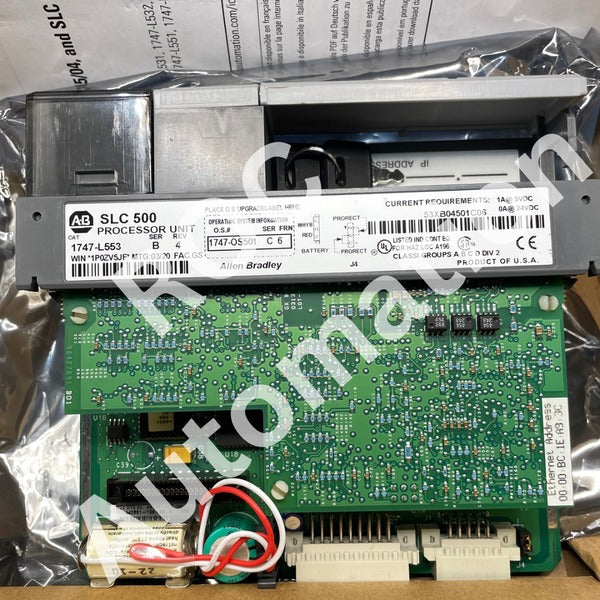Industrial automation is moving fast, and companies across manufacturing, energy, and processing sectors are constantly looking for components that enhance reliability, scalability, and flexibility. Choosing the right programmable logic controllers (PLCs), human-machine interfaces (HMIs), and memory cards can make a significant difference in efficiency and uptime.
Let’s explore how some widely used components play a role in building smarter systems.
Why Does a PLC Processor Like the 1747-L553 Matter?
A PLC processor acts as the brain of an automation setup. The 1747-L553 is designed for environments that demand real-time control and stability. Its modular architecture allows engineers to integrate multiple input and output modules while ensuring dependable performance.
Key benefits include:
· Ability to handle complex tasks in medium to large automation systems
· Faster communication through Ethernet connectivity
· Easy integration with existing industrial networks
This type of processor provides long-term value in plants where downtime is not an option.
How Can Compact Controllers Like the 1763-L16AWA Improve Operations?
Not every system needs a large rack-mounted PLC. Smaller operations benefit from compact controllers that save space without sacrificing functionality. The 1763-L16AWA fits perfectly in applications where energy efficiency, space constraints, and cost-effectiveness are priorities.
What makes it useful?
· Built-in communication ports that simplify remote monitoring
· User-friendly design for quick setup and programming
· Support for up to 16 I/O points, balancing simplicity with flexibility
Compact controllers like this bring modern automation to facilities that don’t need oversized hardware but still demand precision.
What Role Does the 2713P-T12WD1 HMI Play in User Experience?
A well-designed interface determines how effectively operators interact with automation systems. The 2713P-T12WD1 offers a clear 12-inch widescreen display, making data visualization and process monitoring more intuitive.
Why this matters:
· Wide, responsive touch interface reduces training time for operators
· Multi-language support enhances usability across global teams
· Advanced graphics improve process control visibility
An HMI isn’t just about displaying numbers—it’s about empowering teams to respond faster, minimize errors, and maintain safer operations.
Why Is Industrial Memory Expansion Like the 6ES7954-8LT03-0AA0 Essential?
Automation systems process vast amounts of data daily. Without reliable storage, managing logs, recipes, and configurations becomes a challenge. The 6ES7954-8LT03-0AA0 memory card provides 32GB of robust storage designed specifically for Siemens SIMATIC controllers.
Advantages include:
· High durability to withstand industrial conditions
· Fast read/write speeds for efficient program handling
· Secure data retention to protect critical configurations
This type of memory expansion ensures that systems can scale while keeping essential data safe and accessible.
What Should Engineers Consider When Selecting Automation Components?
The right choice of automation hardware depends on the scale, complexity, and future growth of a facility. When evaluating processors, controllers, HMIs, and memory cards, consider the following:
· Compatibility: Will the component integrate smoothly with existing hardware and software?
· Scalability: Can the system grow without needing a complete overhaul?
· Durability: Is the device built to withstand harsh industrial environments?
· Ease of Use: Does the design allow operators and engineers to manage it effectively without extensive training?
· Support and Documentation: Are manuals, updates, and technical support readily available?
Balancing these factors leads to systems that perform reliably for years.
How Do These Components Work Together?
While each device has its unique role, their combined effect creates a seamless automation ecosystem:
· The 1747-L553 delivers powerful processing for complex operations.
· The 1763-L16AWA provides a compact solution for smaller setups.
· The 2713P-T12WD1 HMI enhances operator interaction and decision-making.
· The 6ES7954-8LT03-0AA0 secures and manages essential data storage.
Together, they help industries optimize efficiency, reduce downtime, and achieve greater operational control.
Why Does Investing in Reliable Automation Matter Today?
Global competition, rising energy costs, and stricter safety regulations are pushing industries to modernize. Reliable automation components:
· Reduce human error and downtime
· Support predictive maintenance through data collection
· Enable smoother integration with Industry 4.0 technologies
· Improve sustainability by optimizing energy use
In an era where efficiency equals profitability, smart investment in dependable automation hardware is no longer optional—it’s essential.

